There are two kinds of movies on this page. Some are from large-scale simulations performed with LAMMPS and submitted by users. Others are simple animations of (mostly) 2d problems that illustrate the kinds of simulations that LAMMPS can be easliy used to run. This page has additional snapshots from LAMMPS simulations but without animations.
The animations from large simulations were created using various visualization packages to read LAMMPS output.
These simple animations are from the examples sub-directory of the LAMMPS distribution and are described in this section of the LAMMPS documentation. Most of these examples have 2 animations provided. The first is using a now-outdated xmovie program we used to distribute with LAMMPS. The second using JPG snapshots created on the fly by the dump image command.
These animations are from the examples/ASPHERE sub-directory of the LAMMPS distribution and are described in examples/ASPHERE/README. They are animations of the various kinds of aspherical models LAMMPS supports, namely point ellipsoids, rigid bodies, and generalized aspherical particles made of line/triangle facets in 2d/3d. Many are solvated systems using the coarse-grained SRD solvent provided by the fix srd command. For most of the systems, both a self-diffusivity and viscosity model are shown, the latter using the Muller-Plathe algorithm via the fix viscosity command. Most of the animations were made from JPG snapshots created on the fly by the dump image command. Those for the line and triangle models were created by the Pizza.py toolkit.
These animations are from the examples/VISCOSITY sub-directory of the LAMMPS distribution and are described in examples/VISCOSITY/README. They are animations of 3 flavors of non-equilibrium (NEMD) simulations for measuring the viscosity of a simple 2d LJ fluid. The animations were made from JPG snapshots created on the fly by the dump image command.
For all movies on this page, click on the small image to trigger the animation. If you do not have a browser plug-in that works with the movie format, you can download the movie file itself, e.g. by right clicking on the image and saving the link.
You may need to slow-down/speed-up the MPEG playback on your machine. If your browser uses the xanim program to view MPEG movies, the speed-up key is "-" and the slow-down key is "=".
This is work by Joel Clemmer (Sandia) using the bonded particle model (BPM) package they added to LAMMPS where particles are connected by bonds to model solid mechanics. Bonds contain history, remembering their reference state and/or strain history, and can break to model fracture.
The first video is the bpm/pour example in the LAMMPS distribution where elongated elastic objects constructed out of bonded particles are dropped into a cylindrical cup.
In the second video, a granular system is compacted to a nearly fully dense state. Spherical grains are constructed out of a collection of bonded particles that produce an isotropic linear elastic response. Color represents different grains.
The third video is a two-dimensional example of fragmentation where a solid block of material is continually sheared until it breaks into millions of power-law distributed fragments. Kraynik-Reinelt boundary conditions, the 2D analog of the UEF package, are used to reach large strains. Color indicates the number of broken bonds.
Lastly in the fourth video, a polymer-bonded granular composite is loaded to failure. Spherical nearly-rigid grains are inserted into a matrix of plastic binder. Three types of bonds are used, a very stiff elastic bond between grain-grain particles, a softer elastic interfacial bond between grain-polymer particles, and an elastic-perfectly-plastic bond between polymer-polymer particles. Color indicates the number of broken bonds.
All visualizations were performed with OVITO.


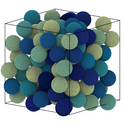

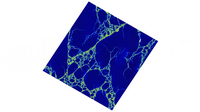

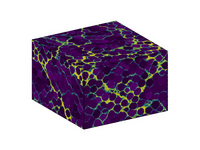

4 snapshots and 4 MP4 movies
These papers have further details:
Critical Scaling of Solid Fragmentation at Quasistatic and Finite Strain Rates, J. T. Clemmer and M. O. Robbins, Physical Review Letters, 129, 078002 (2022). (abstract)
Exploring pressure-dependent inelastic deformation and failure in bonded granular composites: An energetic materials perspective, J. T. Clemmer, K. N. Long, and J. A. Brown, Mechanics of Materials, 184, 104693 (2023). (abstract)
A soft departure from jamming: the compaction of deformable granular matter under high pressures, J. T. Clemmer, J. M. Monti, and J. B. Lechman, Soft Matter, 20, 1702-1718 (2024). (abstract)
This is work by Joel Clemmer (Sandia) and Thomas O’Connor (CMU) using the new RHEO package they developed for LAMMPS. The videos are scaled up adaptations of example input scripts included in the LAMMPS distro and are further described in the papers cited below.
In the first video, a water balloon consisting of an elastic BPM (bonded particle model) membrane encasing an SPH fluid collides with a floor and rebounds. The color of fluid particles qualitatively indicates their vertical velocity.
In the second video, the water balloon is replaced by a brittle ovoidal object with a BPM shell that fractures on impact releasing the fluid.
The third video is of a solid column that is directionally heated on one side. As the solid melts, elastic bonds are deleted and fluid particles begin to flow downward. Surface fluid particles form a thin shell akin to oxidation that redirects flow. Particle temperature and oxidation status are indicated by color.
All visualizations were performed with OVITO.
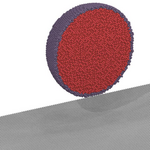

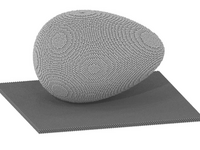

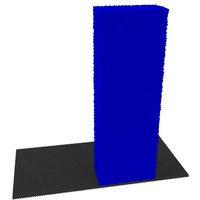

3 snapshots and 3 MP4 movies
These papers have further details:
Reproducing Hydrodynamics and Elastic Objects: A Hybrid Mesh-Free Model Framework for Dynamic Multi-Phase Flows, E. T. Palermo, K. T. Wolf, J. T. Clemmer, and T. C. O’Connor, in review (2024). (abstract)
A hybrid smoothed-particle hydrodynamics model of oxide skins on molten aluminum, J. T. Clemmer, F. Pierce, T. C. O’Connor, T. D. Nevins, E. M. C. Jones, J. B. Lechman, J. Tencer, Applied Mathematical Modelling, 130, 310-326 (2024). (abstract)
This is work from the Czech Technical University in Prague, in the Advanced Materials Group headed by Tomas Polcar, by Alberto Fraile (now: a.fraile at bangor.ac.uk) and Prashant Dwivedi (dwivepr1 at fel.cvut.cz). It was done in collaboration with Giovanni Bonny (Nuclear Materials Science Institute, SCK CEN, Belgium).
Atomistic mechanisms of damage initiation during high velocity (up to 9 km/s, KE up to 200 keV) impacts of W projectiles on a W surface were investigated with LAMMPS. Sample sizes up to 40 million atoms were used. Various aspects of the impacts were analyzed, including massive plastic deformation, breakup, melting, and vaporization.
The first two movies are 100 ps visuzlizations of a 2 nm W cube impacting a large W single-crystal target at a velocity of 3.5 km/s. The 1st the crater creation and damage process. The 2nd is the same system in an isometric view.
The 3rd movie shows sputtered atoms for the same system at an impact velocity of 5 km/s. Color coding represents kinetic energy (blue = low, red = high). The 4th movie shows the combined processes side by side: a) volume of the crater b) evolution of total dislocation length and c) formation of sputtered atoms. The fifth movie presents details of the crater with real-time plots of total dislocation length, kinetic energy, and crater volume.
All visualizations were performed with OVITO.



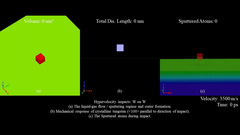

5 MP4 movies
This paper has further details:
Analysis of hypervelocity impacts: the tungsten case, A. Fraile, P. Dwivedi1, G. Bonny, T. Polcar, Nuclear Fusion, 62, 026034 (2022). (abstract)
This work is by Steve Plimpton (Sandia) and Danny Perez and Art Voter (LANL) using the accelerated MD method known as local hyperdynamics to simulate the surface diffusion of adatoms on a Pt(100) surface. A large 2.4 million atom simulation (half of them mobile) with 4% adatoms (~12,000) randomly placed on the surface was run for 32 million timesteps using a time boost factor of 1000x, so that the surface evolved at 400K for 160 us. The simulation was performed on 64 nodes of the Theta supercomputer (Intel KNL nodes) at Argonne's ALCF facility. Adatoms grew into clusters as large as 15 atoms over this timescale.
The first image shows common events that adatoms undergo when they are part of isolated monomers, dimers, or trimers. Almost all events in this system involve exchanges between adatoms and substrate atoms. The second and third images are the initial and final snaphots from a movie of the full system. Orange atoms are in the substrate. Black adatoms are monomers. White adatoms are in clusters. The movie was made from simulation snapshots rendered by Mitch Wood (Sandia) using the Ovito visualization package.

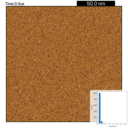
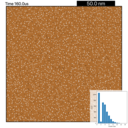

Three images and a 11 MB MP4 movie
This paper has further details:
Parallel algorithms for hyperdynamics and local hyperdynamics, S. J. Plimpton, D. Perez, A. F. Voter, J Chem Phys, 153, 054116 (2020). (abstract)
This work is by Kirill Lykov (kirill.lykov at usi.ch), and Yasaman Nematbakhsh et. al. at USI (Switzerland), NUS (Singapore), MIT (USA) to develop a new model for eukaryotic cells mechanics in a flow. The cell model incorporates a plasma membrane, nucleus envelope and internal cytoskeleton. It can be used to study cell deformations in microfluidic devices.
The movie shows simulations of two experiments: micropipette aspiration and flow in a microfluidic device. Mitsuba Renderer was used for the rendering.
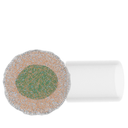
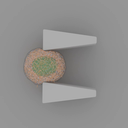

Two images and 2 MB QTime movie
This paper has further details:
Probing eukaryotic cell mechanics via mesoscopic simulations, K. Lykov, Y. Nematbakhsh, M. Shang, C. T. Lim, I. V. Pivkin, PLOS Computational Biology 13, e1005726 (2017). (doi:10.1371/journal.pcbi.1005726) (abstract)
This is work by Stefan Paquay () and Remy Kusters at Eindhoven University of Technololgy, The Netherlands, who developed an algorithm for performing molecular dynamics on arbitrary manifolds (2d surfaces), using a variant of the RATTLE algorithm. It uses Cartesian coordinates, so that it fits nicely into the parallel spatial decomposition strategy of LAMMPS. The code they added in the MANIFOLD package allows users to define and add their own manifolds.
The first two images (2nd is a movie) are of a virus capsid protein model. The second two images (2nd is a movie) are of lateral diffusion of proteins in a large curved membrane.
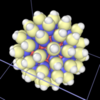
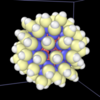



Image, 2 MB MPG movie, image, 11 MB AVI movie, image
This paper has further details:
A Method for Molecular Dynamics on Curved Surfaces S. Paquay and R. Kusters, Biophysical Journal, 110, 1226-1233 (2016). (doi:10.1016/j.bpj.2016.02.017) (abstract)
This is work by Kirill Lykov (kirill.lykov at usi.ch), Xuejin Li et al at the USI, Switzerland and Brown University, USA to develop new Open Boundary Condition (OBC) methods for particle-based methods suitable to simulate flow of deformable bodies in complex computational domains with several inlets and outlets.
The image (left) and movie (right) show the application of the OBCs to red blood cell flow in a straight pipe, bifurcation, and a part of a capillary network. The program Blender was used for the rendering.
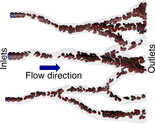

13 Mb MP4 movie
This paper has further details:
Inflow/Outflow Boundary Conditions for Particle-Based Blood Flow Simulations: Application to Arterial Bifurcations and Trees, K. Lykov, X. Li, H. Lei, I. V. Pivkin, G. E. Karniadakis, PLoS Computational Biology 11(8): e1004410 (2015). (doi:10.1371/journal.pcbi.1004410) (abstract)
This is work by Shengfeng Cheng (smcheng at sandia.gov) and Gary Grest at Sandia, to model self-assembly of nanoparticles at a liquid-vapor interface, induced by evaporation of the surrounding solvent. The quality of the remaining nanoparticle crystal structure is a result of the competition between evaporation rate and nanoparticle diffusion time.
The first figure shows snapshots of the simulation from different views. The second is a Voronoi tesselation of the top layer of the nanoparticle substrate. The coloring in both figures is based on a hexagonal order parameter for the local neighborhood of each particle. The third figure is an animation of the evaporation and ordering process.
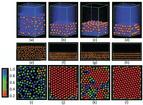



2.2 Mb MPG movie
This paper has further details:
Molecular dynamics simulations of evaporation-induced nanoparticle assembly, S. Cheng and G. S. Grest, J Chem Phys, 138, 064701 (2013). (abstract)
This is work of Dan Mordehai (danmord at tx.technion.ac.il) and co-authors on a combined experimental-computational study of the strength of metallic nanoparticles. This combined study allows studying dislocation nucleation from the surfaces in strong stress-gradients.
The animations show the dislocation activity in a 9.8 nm nanoparticle during molecular dynamics simulations of compression (left) and indentation (right)), as viewed from the [111] direction (from the bottom of the particle). Only atoms on free surfaces and in the defect cores are shown; atoms in stacking faults are shaded in gray. Under compression, dislocations are nucleated at the upper vertices, with a size dependent nucleation threshold. During indentation. dislocation are nucleated beneath the tip and are clearly starved on the surfaces.
3d versions of the movies can be viewed at http://nanomechsim.technion.ac.il, which requires 3d red-blue glasses.
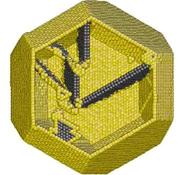
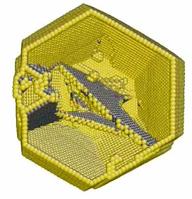
6 and 10 Mb WMV movies
These papers have further details:
Size effect in compression of single-crystal gold microparticles, Mordehai, Dan and Lee, Seok-Woo and Backes, Bjoern and Srolovitz, David J. and Nix, William D. and Rabkin, Eugen, ACTA MATERIALIA, 59, 5202-5215 (2011). (DOI: 10.1016/j.actamat.2011.04.057) (abstract)
Nanoindentation size effect in single-crystal nanoparticles and thin films: A comparative experimental and simulation study, Mordehai, Dan and Kazakevich, Michael and Srolovitz, David J. and Rabkin, Eugen, ACTA MATERIALIA, 59, 2309-2321 (2011). (DOI: 10.1016/j.actamat.2010.12.027) (abstract)
This is work by Paul Crozier (pscrozi at sandia.gov) and Jeff Greathouse (jagreat at sandia.gov) at Sandia to use a grand-canonical Monte Carlo algorithm (see the fix gcmc command) coupled with MD to model radioiodine occupancy within zeolites.
The movie shows the evolution of the zeolite framework from empty to equilibrated full occupancy.
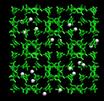
2 Mb WMV movie
This paper has further details.
Capture of Volatile Iodine, a Gaseous Fission Product, by Zeolitic Imidazolate Framework-8, Sava, Dorina F. and Rodriguez, Mark A. and Chapman, Karena W. and Chupas, Peter J. and Greathouse, Jeffery A. and Crozier, Paul S. and Nenoff, Tina M., JOURNAL OF THE AMERICAN CHEMICAL SOCIETY, 133, 12398-12401 (2011). (DOI: 10.1021/ja204757x) (abstract)
This is work by Alexey Shaytan (alexey.shaytan at uni-ulm.de) et al. at the Dept of Energy-Related Nanomaterials (Ulm University, Germany) on a large-scale fully atomistic MD simulation of the amyloid-like nanofibers formed by the conjugates of oligothiophenes and oligopeptides. Such compounds are very promising for applications in organic electronics (conductive organic nanowires).
The movies show the evolution of fibrils based on various intermolecular arrangements. The first is the evolution of single layer fibril based on antiparallel arrangement of beta-sheets. The second is the evolution of a double layer fibril based on parallel arrangement of beta-sheets. The thrid is the adsorption of a fibril on a graphite surface.
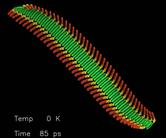
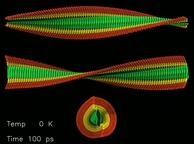

5 Mb Quick Time movies
These papers have further details.
Self-assembling nanofibers from thiophene-peptide diblock oligomers: a combined experimental and computer simulations study, A. K. Shaytan, E.-K. Schillinger, P. G. Khalatur, E. Mena-Osteritz, J. Hentschel, H.G. Börner, P. Bäuerle, A. R. Khokhlov, ACS Nano, 5, 6894–6909 (2011), DOI: 10.1021/nn2011943. (abstract)
Large-scale atomistic simulation of a nanosized fibril formed by thiophene-peptide “molecular chimeras”, A. K. Shaytan, A.R. Khokhlov, P.G. Khalatur, Soft Matter, 6, 1453—1461 (2010), DOI: 10.1039/b918562c. (abstract)
This is work by Jan-Michael Carrillo (U Conn) and collaborators on the layer-by-layer assembly of charged nanoparticles adsorbing out of solution onto a porous substrate with cylindrical pores.


Image and 25 Mb MPEG movie
This paper has further details:
Layer-by-Layer Assembly of Charged Nanoparticles on Porous Substrates: Molecular Dynamics Simulations, J.-M. Carrillo and A. V. Dobrynin, ACS Nano, 5, 3010-3019 (2011). (abstract)
This is work by Georg Ganzenmuller (georg.ganzenmueller at emi.fhg.de) at the Fraunhofer-Institute for High-Speed Dynamics at the Ernst Mach Institute in Germany. He has implemented the SPH pacakge in LAMMPS to perform SPH simualations.
The first animation is of the classic dam break problem, where a column of water collapses. It is described more fully in this PDF guide.
The second movie is a chewing-like destruction of some sample sausage due to repeated application of an indenting cylinder. At the bottom of the container is a little bit of water.
The third animation is an SPH simulation of the same process. In the center panel frame, we have the container (gray), which is visualized sliced open in order to permit looking inside. Water is the light blue surrounding the yellow (sausage). The indenter is colored in magenta. This visualization looks like FEM because the SPH particles have been interpolated onto a regular grid, visualized via LLNL's VisIt program. In the left panel, only water, sausage, and the container is shown. Water is colored according to salt content. As the sausage is ruptured and deformed during the indentation cycles, salt diffuses from the sausage into the water, which changes color accordingly. In the right panel, damage of the sausage is color-coded.
The physics contained in the food simulation is as follows:
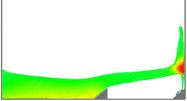

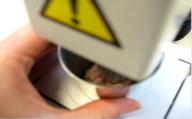



3 images and 3 AVI movies (10, 6, 56 Mb)
This is work by Mike Sangid (sangidm at gmail.com) at Purdue University (formerly at University of Illinois) to study the energy barriers for dislocations to transmit through and nucleate from specific types of grain boundaries (GBs).
The pictures display comparisons of in-situ TEM (transmission electron microscopy) images with snapshots of simulations indicating the same dislocation reactions are observed in experiments and simulations, in cases of slip transmission though a sigma 13 GB (left) and sigma 19 GB (right).
The first movie displays the dislocation reaction for slip transmission with a sigma 3 GB (coherent twin). For clarity, only the atoms representing defects are shown. The second movie displays a cross-sectional view of a contour plot of the energy for the same slip-sigma 3 GB reaction.

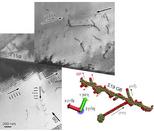


2 images and 2 AVI movies
This paper has further details:
Energy of slip transmission and nucleation at grain boundaries, M. D. Sangid, T. Ezaz, H. Sehitoglu, and I. M. Robertson, Acta Mater 59, 283-296 (2011). (abstract)
This is work by Andres Jaramillo-Botero and collaborators at Caltech to demonstrate the capabilities of their electron force field (eFF) implementation in LAMMPS for studying large-scale, non-adiabatic, explicit-electron dynamics of materials and systems under extreme conditions.
The first image below shows the onset of lithium metal plasma formation immediately after a high-energy collision between a piston wall moving at 20km/s and an fcc lithium crystal slab (close to a million particles). The shock wave front, moving from left to right at a velocity Us (higher than that of the piston, Up), is identified by the transition in material density (higher behind the shock front) and a clear phase transition, from the original fcc crystal structure to a compressed, highly amorphous state. Nuclei are represented by small blue dots of fixed size, while electrons using lime colored spheres. The coloring scheme used shows electrons transitioning from their stable orbitals (yellow grades), through higher energy states in the compressed region (green grades), up to delocalized (ionized) states with a higher positive total energy (shown via swollen red spheres, some of which are hidden by the periodic boundary representation). From the kinematics and dynamics of such simulations we are able to determine the materials shock Hugoniot (see plot), as well as the necessary information to characterize the different phase states that appear along this particular path of the EOS, such as, fraction of ionized electrons as a function of impact speed to establish the onset of a plasma phase.
The movie shows an eFF simulation of the ionization process occuring when two lithium fcc crystal slabs collide at 20km/s. The nuclei on each slab are color-coded points, while the electron floating spherical Gaussians are represented by translucent red and blue spheres corresponding to up down spin, respectively (initially not perceptible, since they remain localized and with small kinetic energy near a nucleus). As the initial collision takes place the shock wave front propagates outward from the impact center, to form a warm dense plasma state with delocalized (swollen) electrons 'floating' around. Another phenomena that is clearly observed on expansion, is the formation of lithium dendrites.

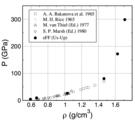
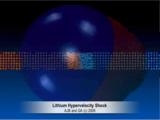

3 images and a 5.5 Mb QuickTime movie
This paper gives details of the eFF implementation in LAMMPS, which is in the EFF package. The pair_eff command doc page is a good place to start.
Large-Scale, Long-Term Nonadiabatic Electron Molecular Dynamics for Describing Material Properties and Phenomena in Extreme Environments, A. Jaramillo-Botero, J. Su, A. Qi, W. A. Goddard III, J Comp Chem, 32, 497-512 (2011). (abstract)
This is work by James Landry (jwlandry at gmail.com), formerly at Sandia, now at MIT Lincoln Labs, modeling flow of granular material from a hopper. Such models can be used to study flow rates and mixing as a function of geometry, or jamming that can occur near the mouth of the hopper.
The first two movies are continuous hopper flow through a reduced diameter nozzle. The second movie is the same as the first, but showing a band of material as it separates due to wall friction. The third movie is actually of packing into a cylindrical container, not hopper flow.



These are 2 to 5 Mb AVI movies.
These papers have further details:
Jamming in granular hopper flow, J. W. Landry and G. S. Grest, ARXIV.
Confined granular packings: Structure, stress, and forces, J. W. Landry, G. S. Grest, L. E. Silbert, S. J. Plimpton, Phys Rev E, 67, 041303 (2003). (abstract)
This is work by Christoph Kloss (christoph.kloss at jku.at) and Christoph Goniva at the Johannes Kepler University (JKU) in Austria, on discrete element modeling (DEM) using their LIGGGHTS software package which extends the granular package in LAMMPS. All but the last of these movies are for particle-only systems. The final movie shows a new capability he and a colleague have developed to perform hybrid simulations of DEM particles in a background fluid, which has been done in LIGGHTS by coupling LAMMPS to the OpenFoam computational fluid dynamics (CFD) package. The visualizations were performed with Paraview.
(a) Speed-up of particle loading simulations by removing particles at rest from the simulation.
(b) Particles flowing into and out of a hopper.
(c) A shear force is exerted on the particles via moving walls.
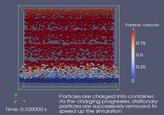
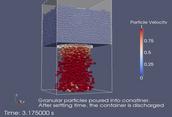
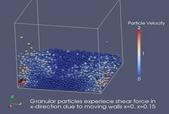
(d) Modified version of the LAMMPS examples/pour/in.pour simulation, done in si units, with more sophisticated visualization.
(e) Illustrates how granular particles can be lumped together as a rigid body. This technique could be used to implement the so-called "multi-sphere method" where non-spherical particles are modelled by multiple spheres.
(f) Mimics the shrinking of particles in an industrial process, e. g. in a blast furnace or other processes involving combustion. If the particles are in a predefined region, their diameter is reduced over time.
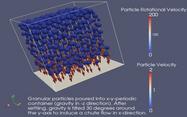
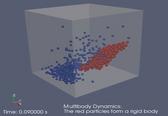
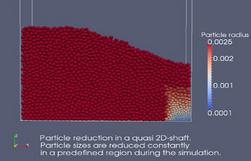
(g) Particles falling into a basin filled with fluid (assumption: the fluid is at rest, no 2-way coupling) and experiencing a drag force. For more realistic results, see the last movie of a coupled DEM-CFD simulation.
(h) Simulation of a partially fluidized bed where a force is added in a region, which fluidizes the particles. For more realistic results, see the last movie of a coupled DEM-CFD simulation.
(i) A fully-coupled parallel DEM-CFD simulation using LAMMPS and OpenFoam.
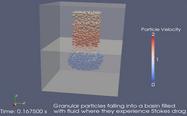
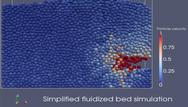
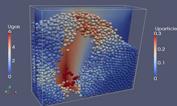
All but one of these links are to WMV movies files of size 2 to 6 Mb. The final movie (i) is a 3 Mb AVI file.
This is work of Gopinath Subramanian (gop.sub at gmail.com) and Catalin Picu at RPI on the effect of friction in the dynamics of fiber networks. In the movie, a mass of randomly oriented fibers undergoes isostatic compression, and is then allowed to expand. Upon expansion, the originally uniform density fiber network is transformed into a heterogeneous solid with pockets of fiber-rich and fiber-deprived regions. The visualization was done using VMD.
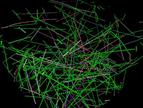
13 Mb MPEG movie
This is work by Ed Webb (ebwebb at sandia.gov) at Sandia and Jeff Hoyt at McMaster University to study the interface between Cu and Ni under conditions of brazing to join the metals. A direct correlation between the free energy of the dissolution reaction and the kinetics of pore infiltration was observed.
The snapshots and movie show liquid Cu infiltration into a 10 nm Ni slit pore at 1750K. Cu and Ni atoms are rendered as light and dark spheres. In the figure, results are shown for the non-dissolutive (left) and the dissolutive (right) simulations at varying simulation times: (a) t = 400 ps, (b) t = 900 ps and (c) t = 1400 ps.


Image and 14.5 Mb animated GIF movie
This paper has further details:
Molecular dynamics study of liquid metal infiltration during brazing, E. B. Webb III and J. J. Hoyt, Acta Materialia, 56, 1802-1812 (2008). (abstract)
This is work of Mike Parks at Sandia (mlparks at sandia.gov). We implemented a Peridynamics (PD) model in LAMMPS to enable meso- and continuum-scale simulations of materials response. PD is a particle-based meshless continuum model that is well-suited for hi-deformation problems, such as impact and fracture scenarios. The theory underlying PD was developed by Stewart Silling at Sandia (sasilli at sandia.gov).
In these images a 1 cm ball (not shown) moving at 100 m/sec impacts a circular disk of brittle material composed of about 100K particles. The timestep is 1 nsec and the simulation runs for 200K timesteps.
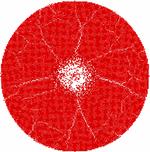

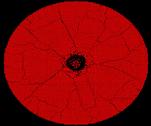

Two images and two 17 Mb AVI movies
This paper gives details of the implementation of PD in LAMMPS and more info about this test problem:
Implementing peridynamics within a molecular dynamics code, M. L. Parks, R. B. Lehoucq, S. J. Plimpton, S. A. Silling, Comp Phys Comm, 179, 777-783 (2008). (abstract)
This is work due to Craig Maloney at CMU (craigmaloney at cmu.edu) and Mark Robbins at JHU. They studied fracture in an idealized 2d brittle material using Lennard-Jones potentials and bonds. Initial bonds were inferred from nearby atom pairs in a quenched system, then were allowed to break as the system was strained. When the solid is deformed, it can relax by breaking bonds, resulting in the damage patterns shown in these figures for a model undergoing shear with 200K particles. The two images plot the sine of the local rotation angle due to deformation in black/white and the autocorrelation of the local rotation in color, evidencing strong anisotropy. The right figure plays a movie of the induced damage.
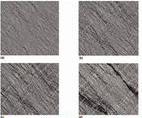
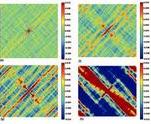
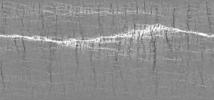
Two images and 2.6 Mb AVI movie
This paper gives details of the work:
Shear faults in a model brittle solid, C. E. Maloney and M. O. Robbins, Chaos, 17, 041105 (2007). (abstract)
This is work due to Nikolai Priezjev (priezjev at egr.msu.edu) and his group at Michigan State. The first study is of how fluid flow is affected by molecular-scale interactions at a solid-liquid interface. The solid surface is patterned with alternating stripes with no-shear and finite-slip attributes, a flow is induced in the liquid above the surface, and the dynamical structure of the fluid is observed. The second study is of short polymer chains flowing over a rough surface. The flow properties are a function of the corrugation wavelength and chain length.

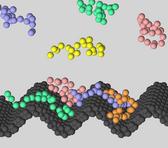
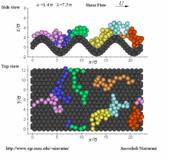
2 Mb and 7 Mb animated GIF movies, image in middle
These papers give full details of the work:
Rheological study of polymer flow past rough surfaces with slip boundary conditions, A. Niavarani and N. V. Priezjev, J Chem Phys, 129, 144902 (2008). (abstract)
Slip behavior in liquid films on surfaces of patterned wettability: Comparison between continuum and molecular dynamics simulations, N. V. Priezjev, A. A. Darhuber, S. M. Troian, Phys Rev E, 71, 041608 (2005). (abstract)
This is work of Richard Gee (gee10 at llnl.gov) and Naida Lacevic (lacevic2 at llnl.gov) at LLNL to study the onset of polymer crystallization via spinodal phase separation. The image (left) shows a snapshot of the polyethylene (PE) melt with an ordered polymer domain in a fringed micelle-like morphology. The movie (right) is a brief animation of the ordering transition from a large simulation of 5832 PE chains each with 768 monomers (4.5M united atoms), run for 45 nanoseconds.

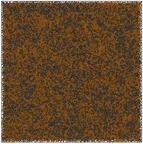
Image and 3.5 Mb QuickTime movie
This paper gives full details of the work:
Atomistic Simulations of Spinodal Phase Separation Preceding Polymer Crystallization, R. H. Gee, N. Lacevic, and L. E. Fried, Nature Materials, 5, 39-43 (2006). (abstract)
This is work by Alexey Kuksin, Vladimir Stegailov, Genri Norman and Alexey Yanilkin (Joint Institute for High Temperatures, Russian Academy of Sciences) on the melting of polycrystalline metal under ultrafast isochoric heating.
The animation shows melting of polycrystalline copper with nanosized grains subjected to ultrafast isochoric bulk heating. Atoms are colored by their centro-symmetry parameter. Lighter atoms correspond to a more disordered local environment that allows distinguishing grain boundaries and melting front propagation. The visualization was done with the AtomEye program.
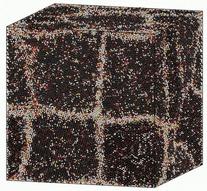
5.5 Mb animated GIF movie
This paper has further details:
Surface melting of superheated crystals. Atomistic simulation study, A. Y. Kuksin, G. E. Norman, V. V. Stegailov, and A. V. Yanilkin, Comp Phys Comm, 177, 34-37 (2007). (abstract)
This is work by Vladimir Stegailov and Alexey Yanilkin (Joint Institute for High Temperatures, Russian Academy of Sciences) on plastic deformation and void nucleation in a single crystal of shock loaded bcc iron.
The picture shows successive stages of the shock-wave loading of a single crystal of bcc iron. During compression, pulse propagation plastic deformation takes place near the lateral open surfaces (only one of the two surfaces is shown because of the symmetry). It results in formation of inhomogeneties that act as void nucleation sites during spallation during the rarefaction wave. The visualization was done with the AtomEye program.
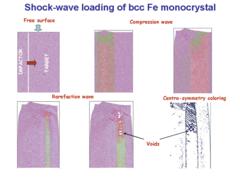
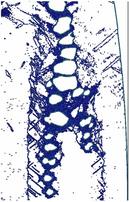
Image and 0.6 Mb animated GIF movie
This paper has further details:
Structural transformations in single-crystal iron during shock-wave compression and tension: Molecular dynamics simulation, V. V. Stegailov and A. V. Yanilkin, J of Expt and Theoretical Physics, 104, 928-935 (2007). (abstract)
This is work by Alexey Kuksin, Vladimir Stegailov and Alexey Yanilkin (Joint Institute for High Temperatures, Russian Academy of Sciences).
The animation shows the propagation of an isolated edge dislocation in fcc aluminum under shear deformation. Only atoms in the dislocation glide plane are shown. Atoms are colored by their centro-symmetry parameter (blue/yellow colors correspond to prefect fcc/stacking fault structures). The visualization was done with the AtomEye program.
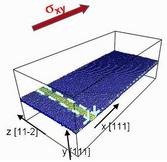
2.5 Mb animated GIF movie
This paper has further details:
Molecular-dynamics simulation of edge-dislocation dynamics in aluminum, A. Y. Kuksin, V. V. Stegailov, and A. V. Yanilkin, Doklady Physics, 53, 287-291 (2008). (abstract)
This is work by Timur Bazhirov, Genri Norman and Vladimir Stegailov (Joint Institute for High Temperatures, Russian Academy of Sciences) on homogeneous cavitation in a liquid metal under negative pressure.
The graph and the animation illustrate spontaneous formation of a bubble in liquid Pb under temperatures and pressures close to the spinodal. Atoms are colored by their coordination number. The visualization was done with the AtomEye program.

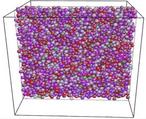
Image and 4.6 Mb AVI movie
This paper has further details:
Cavitation in liquid metals under negative pressures. Molecular dynamics modeling and simulation, T. T. Bazhirov, G. E. Norman, and V. V. Stegailov, J Phys - Condensed Matter, 20, 114113:1-11 (2008). (abstract)
This is work by (Alexey Kuksin, Vladimir Stegailov, Genri Norman and Alexey Yanilkin (Joint Institute for High Temperatures, Russian Academy of Sciences on the influence of nanoprecipitates on shock induced plasticity and subsequent fracture.
Animations show the propagation of weak (left) and strong (right) shock waves in an aluminum (grey atoms) single crystal doped with amorphous copper (yellow atoms) nanoclusters. Only atoms with broken symmetry in their local environment are shown (point defects, stacking faults, etc.) Only atoms in the rear half of the simulation box are visible (the cutting plane is marked). The final atomic structure in the strong shock case corresponds to the spallation stage and is colored according to potential energy of atoms. The visualization was done with the AtomEye program.


2.8 and 1.6 Mb animated GIF movies
This paper has further details:
Atomistic study of nanoprecipitates influence on plasticity and fracture of crystalline metals, V. V. Stegailov, A. Yu. Kuksin, G. E. Norman, and A. V. Yanilkin, AIP Conf Proc "Shock Compression of Condensed Matter - 2007", 955, 339-342 (2007). (abstract)
This is work of Jin Sun (jinsun at iastate.edu) with Francine Battaglia and Shankar Subramaniam at Iowa State to study polydispersity and boundary condition effects on segregation in granular flows. These give rise to the well-known "Brazil nut" phenomenon where shaking a can of nuts causes the larger nuts to rise to the top even though they are heavier. These movies are animations of long simulations (9M timesteps) of a cylindrical domain containing 7600 granular particles.
The large "Brazil nut" particle has a diameter 3x larger and a mass 224x greater than the small particles. The system on the left includes particle-wall friction and the large particle rises to the top after about 30 "shakes" of the system. The system on the right includes no particle-wall friction and the large particle does not rise.


3.5 Mb QuickTime movies
This paper gives details of the work:
Dynamics and structures of segregation in a dense, vibrating granular bed, J. Sun, F. Battaglia, and S. Subramaniam, Phys Rev E, 74 061307. (2006). (abstract)
This is work of Vijay Sutrakar in Roy Mahapatra's group at the Indian Institute of Science on how ultrathin Cu nanowires form due to creation of pentagonal multi-shell nanobridge structures.
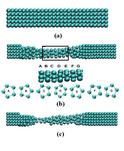

Image and 1.0 MPG movie of nanowire formation
This paper gives further details of the work and Prof Mahaptra's WWW site has more info:
Formation of stable ultra-thin pentagon Cu nanowires under high strain rate loading, V. K. Sutrakar and D. R. Mahapatra, J Physics - Condensed Matter, 20, 335206 (2008). (abstract)
This is work of Wuwei Liang (gtg088c at mail.gatech.edu) in Min Zhou's group at Georgia Tech on how defects in Cu single-crystal nanowires form and propagate under various stress loading and unloading scenarios. Atoms in these movies are colored by their local centro-symmetry value. The movie was made with VMD.


1.0 Mb AVI movies of loading (left) and unloading (right)
This paper gives further details of the work:
Pseudoelasticity of Single Crystalline Cu Nanowires through Reversible Lattice Reorientations, W. W. Liang and M. Zhou, J Engr Materials and Technology, 127, 423-433 (2005). (abstract)
This is work due to Harold Park (harold.park at vanderbilt.edu) at Vanderbilt and Jon Zimmerman (jzimmer at sandia.gov) at Sandia to study how nanowires form under tensile loading at differing strain rates. The image and movie show Au atoms colored by their potential energy for an EAM potential. The movie was made with the Ensight visualization package.
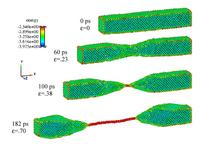
5.0 Mb QuickTime movie
This WWW page gives further details of the work, as does this paper:
Modeling inelasticity and failure in gold nanowires, H. S. Park and J. A. Zimmerman, Phys Rev B, 72, 054106 (2005). (abstract)
This is the work of Paul Crozier (pscrozi at sandia.gov) at Sandia to study how narrow cylindrical pores in silica can regulate the passage water and ions in the presence of a pressure gradient for purposes of desalination. The animation shows amorphous SiO2 in transparent red and yellow, ions in blue and cyan, and water molecules in red and white. Permeation can be calculated from such simulations as a function of pore diameter, pore length, and pressure gradient magnitude.
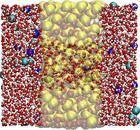
4.0 Mb AVI movie
This is work due to Jon Zimmerman (jzimmer at sandia.gov) at Sandia. It's a study of how helium bubble formation in a metal induces defect formation. As nanobubbles grow, they force the surrounding metal to respond. This movie is an animation of bubble growth in Pd. Each atom is colored by the value of its centro-symmetry parameter, which is a measure of local crystal order; only atoms at defects are visualized.
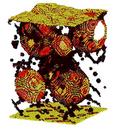
2.2 Mb MPEG movie
This is work due to Paul Crozier (pscrozi at sandia.gov) and Mark Stevens (msteve at sandia.gov) at Sandia. It's a study of the conformational properties of rhodopsin in both dark- and light-adapted states.
The movie shows the loop and helix dynamics the rhodopsin protein in a lipid bilayer (red) surrounded by water (blue) and counter-ions. The movie was made using VMD.

6.4 Mb movie
This paper and related ones on this page have further details:
Molecular dynamics simulation of dark-adapted rhodopsin in an explicit membrane bilayer: Coupling between local retinal and larger scale conformational change, P. S. Crozier, M. J. Stevens, L. R. Forrest, T. B. Woolf, J Molecular Biology, 333, 493-514 (2003). (abstract)
This is work due to Paul Crozier (pscrozi at sandia.gov) at Sandia. It's a study of the properties of the RuBisCO enzyme which is a ubiquitous protein involved in converting CO2 to organic forms of carbon and in the photosynthetic process. Sandia's Genomes-to-Life project is focused on a species of cyanobacteria that uses RuBisCO.
The first movie is an all-atom model (water not shown) with the binding pocket in color. Even though the pocket is closed, a CO2 molecule escapes, which was a surprise. The 2nd movie uses implicit solvent, freezes the protein background, and samples via parallel tempering to model the closing of the binding pocket by the C-terminus of the RuBisCO protein.
These movies were made with VMD.
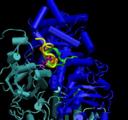
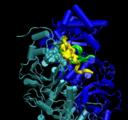
5.5 Mb and 5.1 Mb movies
This is work due to Colin Denniston (cdennist at uwo.ca) and Mark Robbins at JHU. It's a miscible binary fluid with the wall/fluid interactions set such that the top wall is wet by the yellow particles and the bottom wall by the red. This drives a continuous fluid flow in the system, which spins the tiny nano-wheel.

2.0 Mb QuickTime movie
This paper has further details:
Molecular and continuum boundary conditions for a miscible binary fluid, C. Denniston and M. O. Robbins, Phys Rev Lett, 87, 178302 (2001). (abstract)
This is work by Mark Asta's group at Northwestern and Jeff Hoyt (jjhoyt at sandia.gov) at Sandia. The movie shows the motion of a solidification front in Ni where the temperature of the system is carefully thermostatted so that the velocity of the interface can be accurately measured.

4.2 Mb movie
This paper and related ones on this page have further details:
Atomistic simulation methods for computing the kinetic coefficient in solid-liquid systems, J. J. Hoyt, M. Asta, A. Karma, Interfacial Science, 10, 181 (2002). (abstract)
This was work with Ruth Pachter (pachterr%ml%wpafb at mlgate.ml.wpafb.af.mil) at Wright Patterson AFB. We studied the conformation of liquid crystal molecules in crystalline and non-crystalline forms. The movie shows the differences for the 2 cases.

1.5 Mb movie
This paper has further details:
Modeling a nematic liquid crystal, S. S. Patnaik, S. J. Plimpton, R. Pachter, W. W. Adams, Liquid Crystals, 19, 213-220 (1995). (abstract)
Input scripts for these problems from the example/granregion directory: in.granregion.funnel, in.granregion.mixer, in.granregion.box.
These movies illustrate use of the fix wall/gran/region command which enables a region to act as a boundary for granular particles. Regions can be unions or intersections of more primitive geometric shapes and can translate or rotate in time, as detailed by the region command.
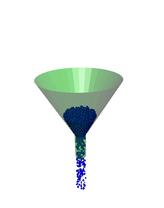
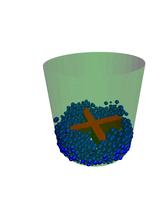
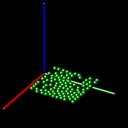
The first two movies were made with VMD. The last was made with the dump image command in LAMMPS. It does not visualize the enclosing cubic box.
Input script for this problem from the examples directories.
A 2d "circle" of particles is placed in a larger box with LJ walls. The circle is given an initial velocity so that it bounces off the walls. In the first movie, it disintegrates. In the second and third movies, bonds are added between neighboring particles via the create_bonds command, to prevent disintegration. In the second movie, the object hits the wall with a slow velocity (longer run, more timesteps between movie frames). In the third movie, the object hits the wall with a fast velocity as in the first movie. In this case, pairwise interactions between 1-3 and 1-4 neighbors within the topology of the bond network need to be turned on, otherwise there is too much overlap of particles and the circle of particles collapses due to the fast collisions with the walls.
In all cases, this problem has an irregular density distribution of particles that varies with time. The fix balance rcb command is used to continuously balance the number of particles per processor. The simulations were run on 8 processors. The processor sub-domain are visualized in the movie, and the particles are colored by which processor owns them.
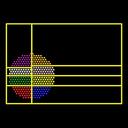


8.1 Mb, 3.5 Mb, 4.0 Mb QuickTime dump image movies
Input script for this problem from the examples directories.
Colloids of diameter 5 are put in a background solvent of Lennard-Jones particles (diameter 1). The big-big and big-small particle interactions are calculated via the pair_style colloid potential in a 2d system. The system is initialized very dilute and then run at constant pressure. The simulation box in the first movie thus shrinks and oscillates initially. In the second movie, made with the dump image command, the displayed box size is scaled to the same value for every frame, so it appears that the particles grow in size as the box shrinks.
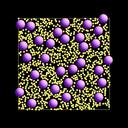
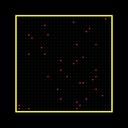
3.3 Mb and 2.5 Mb QuickTime dump image movies
Input script for this problem from the examples directories.
Tensile pull on a 2d solid with 8K atoms to induce crack formation. There is an initial horizontal slit crack between the two small blocks of atoms on the left.
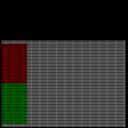

2.0 Mb MPG movie, 2.8 Mb QuickTime dump image movie
Input script for the atomic problem from the examples directories.
Input script for the flexible molecular problem from the examples directories.
Input script for the rigid molecular problem from the examples directories.
The first movie shows deposition of atoms onto a heated atomic substrate. The second movie shows deposition of flexible molecular dimers onto the same substrate. The third movie shows desposition of rigid molecular dimers onto the same substrate. They are held rigid via the fix shake command.
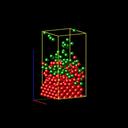
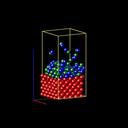
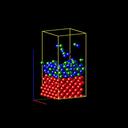
1.8 Mb, 4.7 Mb, and 4.7 Mb QuickTime dump image movies
Input script for this problem from the examples directories.
Particles with point dipoles interact via the pair_style dipole/cut potential in a 2d system. The viz is done by displahing two particles at each site where they are displaced slightly from each other in the direction of the dipole orientation.
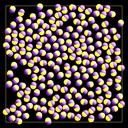
4.2 Mb QuickTime movie
Input script for this problem from the examples directories.
The pairwise GayBerne potential was used to model ellipsoidal particles in a solvent of spherical particles. This is a 2d simulation. The animation was performed with PyMol after converting LAMMPS output to PyMol format with the pymol_asphere tool.
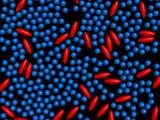
3.3 Mb QuickTime movie
Input script1 and script2 for these problems from the examples directories.
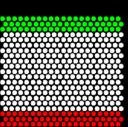
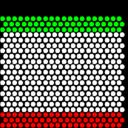
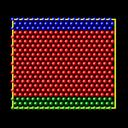
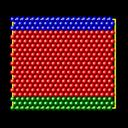
2.0 Mb and 3.1 Mb MPG movies, 4.1 Mb and 3.6 Mb QuickTime dump image movies
Input script for this problem from the examples directories.
Two half-sphere asperities rub against each other.
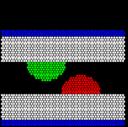
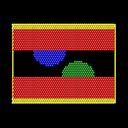
1.6 Mb MPG movie, 3.0 Mb QuickTime dump image movie
Input script for this problem from the examples directories.
The indenter pushes into the top surface and is then removed. Some healing of the lattice is observed after removal.
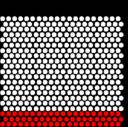
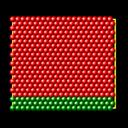
1.4 Mb MPG movie, 2.0 Mb QuickTime dump image movie
Input script for this problem from the examples directories.
The 3-atom lipids have a hydrophilic head that likes solvent and a hydrophobic tail that doesn't like solvent.
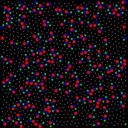
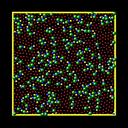
2.7 Mb MPG movie, 3.9 Mb QuickTime dump image movie
Input script for this problem from the examples directories.
A 2d Lennard-Jones fluid is sheared in a non-orthogonal non-orthogonal (triclinic) box using the fix deform commmand. The yellow band of particles disorders over time. These image in the first movie were made with Raster3d.


1.9 Mb QuickTime movie, 1.9 Mb QuickTime dump image movie
Input script for this problem from the examples directories.
Two spherical voids in a flowing atomic fluid.


1.7 Mb MPG movie, 1.6 Mb QuickTime dump image movie
Input script for this 3d problem from the examples directories.
Input script for this 2d molecule problem from the examples directories.
The first two movies are for a 3d problem. The one on the left is a side view of the 3d container into which particles are poured. The one on the right is a different view. After pouring and settling, gravity is set at an angle to induce chute flow.
The last movie is for a 2d problem where rigid V-shaped particles are poured into a box.
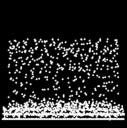
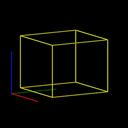
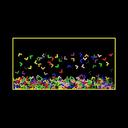
2.3 Mb MPG movie, 1.2 Mb and 1.3 Mb QuickTime dump image movies
Input script1 and script2 for these problems from the examples directories.
Fixed-end shear of a quasi-2d solid (thin and periodic in the z dimension). The presence of a void enables stress relaxation without defect formation in the bulk.
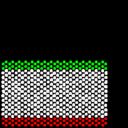
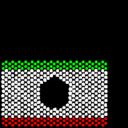
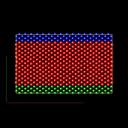
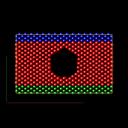
1.7 Mb and 1.7 Mb MPG movies, 0.9 Mb and 0.8 Mb QuickTime dump image movies
Input script1 and script2 for these problems from the examples/ASPHERE directories.


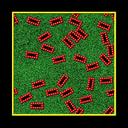

Two images and 13 Mb and 14 Mb QuickTime dump image movies
Input script1 and script2 for these problems from the examples/ASPHERE directories.
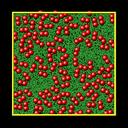

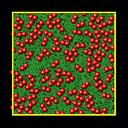

Two images and 11 Mb and 12 Mb QuickTime dump image movies
The ellipsoids appear as spheres with an ellipsoid-shaped solvent-excluded region around them. This is because the dump image command cannot yet draw ellipsoids.
Input script1 and script2 for these problems from the examples/ASPHERE directories.
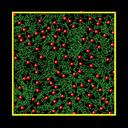

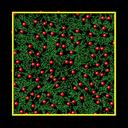

Two images and 12 Mb QuickTime dump image movies
This is a collection of box- and triangle-shaped 2d rigid particles of various sizes. The left images are for an implicit-solvent model, which allows for close packing. The right images are for an SRD solvent model. These systems are being sheared via fix deform, which allows measurement of a viscosity.
Input script1 and script2 for these problems from the examples/ASPHERE directories.




Two images and 15 Mb and 11 Mb QuickTime movies
This is not really an aspherical model, but a poly-disperse collection of finite-size spheroids in SRD solvent.
Input script1 and script2 for these problems from the examples/ASPHERE directories.
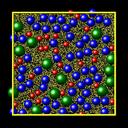



Two images and 11 Mb and 22 Mb QuickTime dump image movies
Input script1 and script2 for these problems from the examples/ASPHERE directories.


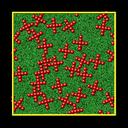

Two images and 13 Mb and 14 Mb QuickTime dump image movies
This is a collection of box-shaped 3d rigid particles of various sizes. They are in an SRD solvent model. The system is being sheared via fix deform, which allows measurement of a viscosity.
Input script for this problem from the examples/ASPHERE directories.
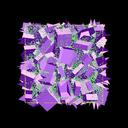

An image and a 7.8 Mb QuickTime movie
Input script for moving wall, input script for NEMD deforming box, and input script for Muller-Plathe algorithm from the examples/VISCOSITY directory.
The left image/movie is for the moving wall, the middle image/movie for the NEMD deforming box, and the right image/movie for the Muller-Plathe algorithm.
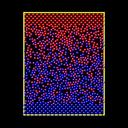

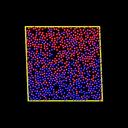



Three images and 5.4 Mb and 4.9 Mb and 8.3 Mb QuickTime dump image movies. Atoms are colored (blue to red) by increasing x-velocity.